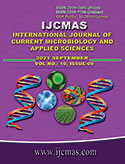


 National Academy of Agricultural Sciences (NAAS)
National Academy of Agricultural Sciences (NAAS)

|
PRINT ISSN : 2319-7692
Online ISSN : 2319-7706 Issues : 12 per year Publisher : Excellent Publishers Email : editorijcmas@gmail.com / submit@ijcmas.com Editor-in-chief: Dr.M.Prakash Index Copernicus ICV 2018: 95.39 NAAS RATING 2020: 5.38 |
In the present study, an effort has been made to study in detail of Land Use/Land Cover Mapping for Sambar watershed by using Remote Sensing and GIS technique was carried out during the year of 2020-2021 in Parbhani district. In this research the Remote Sensing and Geographical Information system technique was used for identifying the land use/land cover classes with the help of ArcGIS 10.8 software. The Sambar watershed is located in 19º35ʹ78.78Ë N and 76º87ʹ88.44Ë E in the Parbhani district of Marathwada region in Maharashtra. It is covered a total area 97.01 km2. The land use/land cover map and its classes were identified by the Supervised Classification Method in ArcGIS 10.8 software by using the Landsat 8 satellite image. Total six classes are identified namely as Agricultural area, Forest area, Urban area, Barren land, Water bodies and Fallow land. The Agricultural lands are well distributed throughout the watershed area and it covers 4135 ha. (43 per cent). Forest occupies 502 ha area and sharing about 5 per cent of the total land use land cover of the study area. The Urban land occupies 390 ha. area (4 per cent) and there was a rapid expansion of settlement area. Barren land occupies 3392 ha. area (35 per cent). A water bodies occupy 630 ha. area (6 per cent) and the Fallow land occupies 650 ha (7 per cent) but well-developed dendritic drainage pattern and good water availability is in the Sambar watershed.
 |
 |
 |
 |
 |